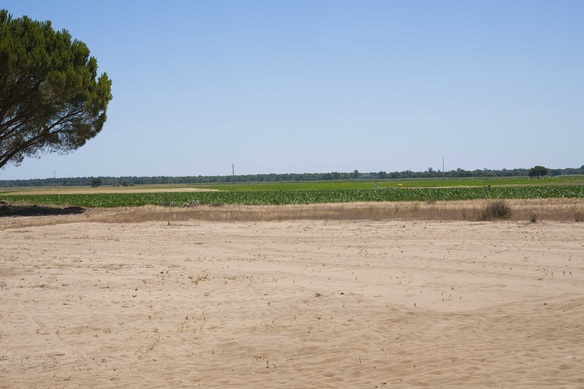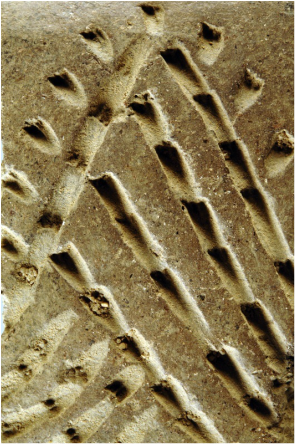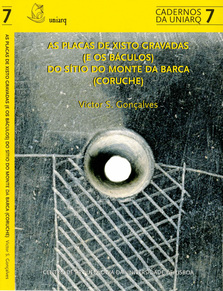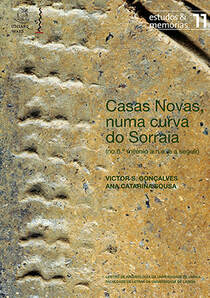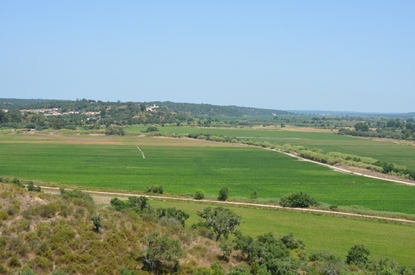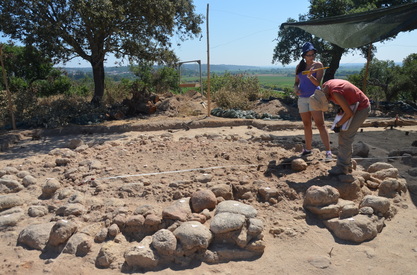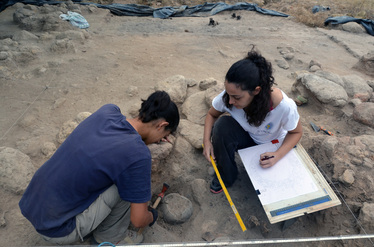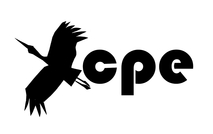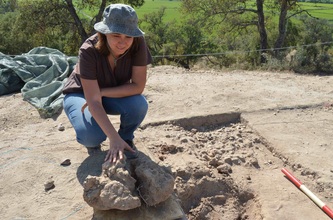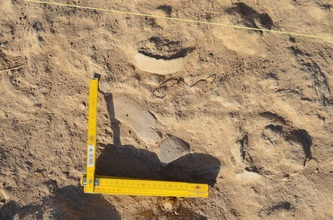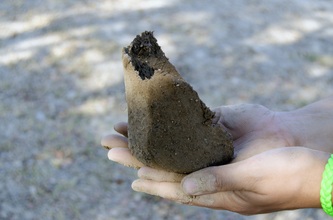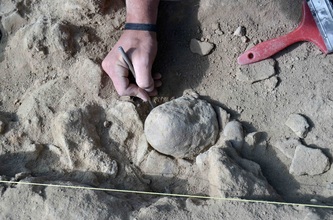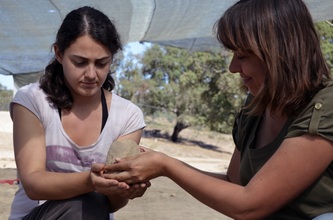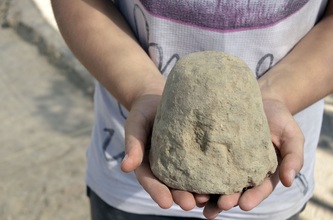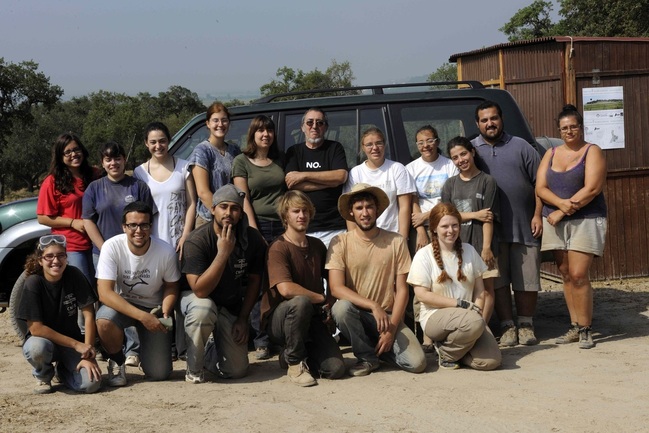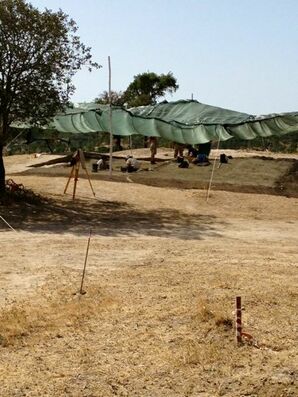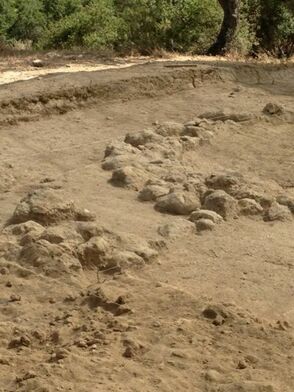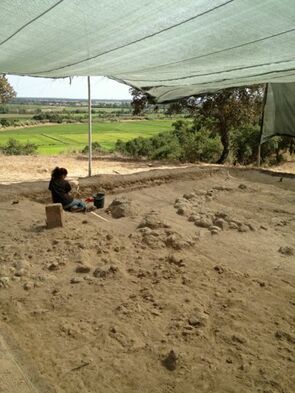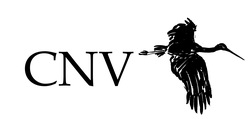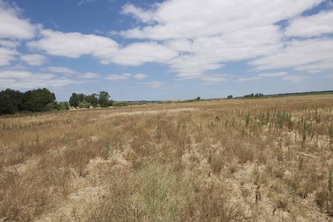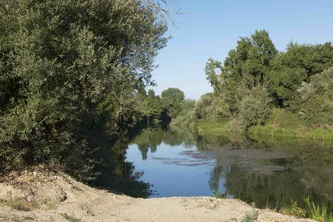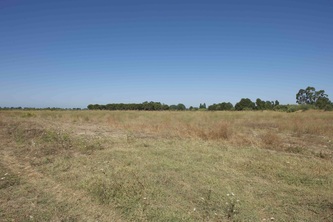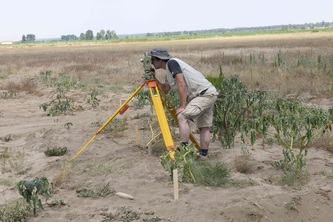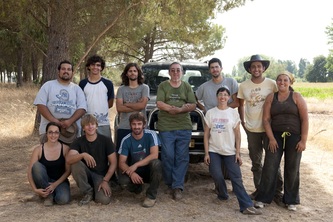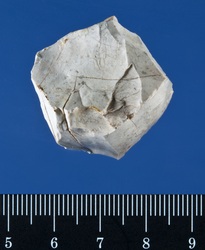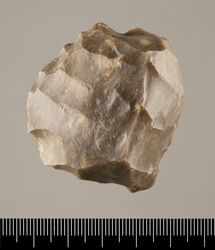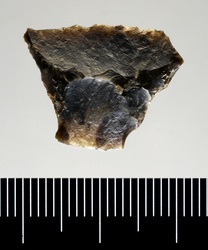The main objective of the Project «Anthropization of the Sorraia Valley» (ANSOR) is to interpret the anthropization of the River Sorraia Valley between the 6thand 2th millennia BCE, namely looking into strategies of implantation, settlement networks, areas of resource collection, technological change, exchanges and cultural influences.
The adopted perspective of long duration ranges from the early farmer communities in process of Neolithization (6th and 5th millennia – Early Neolithic) to the consolidation of first farmers and archaeometallurgist communities of the 3rd millennium BCE, and their decadence and replacement in the 2nd millennium (Early Bronze Age).
This geographical area is located between Portuguese Estremadura and Middle-Alentejo, joining two trajectories of cultural influences. We can also identify more remote influences, from the Spanish Meseta, the Tagus Valley and Andalucía.
This is a project targeted at long duration and therefore encompasses different sets of problems and different territories.
1. Characterization of the early farming communities in the Early Neolithic.
2. Megalithism and Archaeology of Death at Coruche;
3. Archaeometallurgists.
PROJECT ANSOR 1 (1982-1985)
In the early 1980s, Victor S. Gonçalves, together with Suzanne Daveau, defined a research programme for the Sorraia Valley, in the framework of the «Programme for the study of anthropization of the Lower Tagus and its tributaries» (ANSOR 1). This programme, published in the journal Clio Arqueologia(Gonçalves e Daveau, 1983-84), also contemplated the specific situation of the mid-basin of the Sorraia, considered a testing area.
Project ANSOR was developed in 1982 and 1983, was particularly marked by works at the Chalcolithic site of Cabeço do Pé da Erra – CPE (Gonçalves, 1983) and the «geoarchaeological» studies made with Suzanne Daveau (Gonçalves e Daveau, 1983-84).
The project was halted due to lack of financing but remained a reference for the study of Neolithic and Chalcolithic in this regions.
References
GONÇALVES, V. S. (1982) - O povoado calcolítico do Cabeço do Pé da Erra (Coruche). In CLIO, Revista do Centro de História da Universidade de Lisboa. Lisboa. 4, p. 718.
GONÇALVES, V. S. (1983-84a) – Cabeço do Pé da Erra (Coruche), contribuição da campanha 1(83) para o conhecimento do seu povoamento calcolítico. CLIO/ARQUEOLOGIA. Lisboa: UNIARCH. 1. p. 69--‐75
GONÇALVES, V. S.; DAVEAU, S. (1983-1984b) – Programa para o estudo da antropização do Baixo Tejo e afluentes: Projecto para o estudo de antropização do Vale do Sorraia (ANSOR). CLIO, ARQUEOLOGIA, Revista da UNIARCH. Lisboa. Vol. 1, p. 203-206.
GONÇALVES, V. S.; DAVEAU, S. (1983-1984c) – A Uniarch e o projecto Ansor em Coruche. CLIO, ARQUEOLOGIA, Revista da UNIARCH. Lisboa. Vol. 1, p. 272-273.
GONÇALVES, V. S. e DAVEAU, S. (1985) - A evolução holocénica do Vale do Sorraia e as particularidades da sua antropização (Neolítico e Calcolítico). In Actas da I Reunião do Quaternário Ibérico. Lisboa: Centro de Estudos Geográficos da Universidade de Lisboa, 2 p. 187-197.
GONÇALVES, V. S. (1989) – Megalitismo e metalurgia no Alto Algarve Oriental. Uma aproximação integrada. Lisboa: INIC/UNIARQ, 2 vol.
The adopted perspective of long duration ranges from the early farmer communities in process of Neolithization (6th and 5th millennia – Early Neolithic) to the consolidation of first farmers and archaeometallurgist communities of the 3rd millennium BCE, and their decadence and replacement in the 2nd millennium (Early Bronze Age).
This geographical area is located between Portuguese Estremadura and Middle-Alentejo, joining two trajectories of cultural influences. We can also identify more remote influences, from the Spanish Meseta, the Tagus Valley and Andalucía.
This is a project targeted at long duration and therefore encompasses different sets of problems and different territories.
1. Characterization of the early farming communities in the Early Neolithic.
2. Megalithism and Archaeology of Death at Coruche;
3. Archaeometallurgists.
PROJECT ANSOR 1 (1982-1985)
In the early 1980s, Victor S. Gonçalves, together with Suzanne Daveau, defined a research programme for the Sorraia Valley, in the framework of the «Programme for the study of anthropization of the Lower Tagus and its tributaries» (ANSOR 1). This programme, published in the journal Clio Arqueologia(Gonçalves e Daveau, 1983-84), also contemplated the specific situation of the mid-basin of the Sorraia, considered a testing area.
Project ANSOR was developed in 1982 and 1983, was particularly marked by works at the Chalcolithic site of Cabeço do Pé da Erra – CPE (Gonçalves, 1983) and the «geoarchaeological» studies made with Suzanne Daveau (Gonçalves e Daveau, 1983-84).
The project was halted due to lack of financing but remained a reference for the study of Neolithic and Chalcolithic in this regions.
References
GONÇALVES, V. S. (1982) - O povoado calcolítico do Cabeço do Pé da Erra (Coruche). In CLIO, Revista do Centro de História da Universidade de Lisboa. Lisboa. 4, p. 718.
GONÇALVES, V. S. (1983-84a) – Cabeço do Pé da Erra (Coruche), contribuição da campanha 1(83) para o conhecimento do seu povoamento calcolítico. CLIO/ARQUEOLOGIA. Lisboa: UNIARCH. 1. p. 69--‐75
GONÇALVES, V. S.; DAVEAU, S. (1983-1984b) – Programa para o estudo da antropização do Baixo Tejo e afluentes: Projecto para o estudo de antropização do Vale do Sorraia (ANSOR). CLIO, ARQUEOLOGIA, Revista da UNIARCH. Lisboa. Vol. 1, p. 203-206.
GONÇALVES, V. S.; DAVEAU, S. (1983-1984c) – A Uniarch e o projecto Ansor em Coruche. CLIO, ARQUEOLOGIA, Revista da UNIARCH. Lisboa. Vol. 1, p. 272-273.
GONÇALVES, V. S. e DAVEAU, S. (1985) - A evolução holocénica do Vale do Sorraia e as particularidades da sua antropização (Neolítico e Calcolítico). In Actas da I Reunião do Quaternário Ibérico. Lisboa: Centro de Estudos Geográficos da Universidade de Lisboa, 2 p. 187-197.
GONÇALVES, V. S. (1989) – Megalitismo e metalurgia no Alto Algarve Oriental. Uma aproximação integrada. Lisboa: INIC/UNIARQ, 2 vol.
PROJECT ANSOR 2 (2010-2016)
The return to Project ANSOR occurred between 2010 and 2015 with the exclusive support of the municipality of Coruche.
Fieldwork was extensively done at Casas Novas (2010, 2011), including a geophysical survey and excavations covering an enlarged area (404 m2). Traces of a seasonal camp were found at this site, covering a vast area in the left bank of river Sorraia (Gonçalves, 2009). An ancient date was established by radiocarbon (mid-6thmillennium), associated with a collection of ceramics with cardial decoration (one of the largest sets found in the Portuguese territory). A monograph with these results have been published and won an award from Portuguese Academy of History (2018).
Human occupation in the 3rdmillennium BCE is strongly represented at Coruche, in contrast with the remaining territory of Ribatejo. Project ANSOR 2 enabled the identification of 10 new sites. Fieldwork was done at Cabeço do Pé da Erra (CPE), Barranco do Farinheiro (BFR), Senhora do Castelo and Entre Águas (EAG).
Work at CPE included geophysical studies (2011) and four new excavation campaigns (2012-2015), totalling 536 m2. Geophysical studies and excavations on the area enabled the identification of a ditch encircling the settlement, including a minimum of nine huts with stone floors and clay walls. Some cooking areas have been found, as well as areas destined to stone cutting activities, cheese production, weaving and milling. Absolute dating and stratigraphy led to the identification of three phases of occupation from 2,800 to 2,100 BCE.
Negative structures were found at Barranco do Farinheiro (BFR). Located 3.3 km away from CPE, geophysical works and excavations in the area are made difficult by the existence of a dense forest of cork-oak trees. Occupation at BFR was partly simultaneous to CPE, although with a few differences – the most important of which is the presence of Bell-Beaker ceramics (Maritime and Ciempozuelos type), absent from CPE (Gonçalves et al, 2017).
The site of Entre-Águas can be included in this network of settlement. A previous geophysical survey was conducted in 2016.
The 4thand 3rdmillennium necropolises were also studied, namely (1) studies on the artefacts from the megalithic monuments of Coruche deposited at the National Museum of Archaeology (Gonçalves and Sousa, 2014), and(2) a monograph on the engraved schist plaques of Monte da Barca, a funerary context located near the today’s town of Coruche, outside the «megalithic area» (Gonçalves, 2011).
References
GONÇALVES, V. S. (2009) – Um sítio do Neolítico antigo no vale do Sorraia: Casas Novas (Coruche). Revista Portuguesa de Arqueologia. 12, nº 2, p. 5-30.
GONÇALVES, V. S. (2011) – As placas de xisto gravadas (e os báculos) do sítio do Monte da Barca (Coruche). Lisboa: UNIARQ. Cadernos da UNIARQ. 7.
GONÇALVES, V. S.; SOUSA, A. C. (2014) – Coruche e as antigas sociedades camponesas. In Coruche, o céu, a terra e os homens. Coruche: Câmara Municipal. p. 29-67.
GONÇALVES, V. S.; SOUSA, A. C. (2015) – O sítio do neolítico antigo de Casas Novas (Coruche). Leituras preliminares. In GONÇALVES, V. S.; DINZ, M.; SOUSA, A. C., eds– Actas do 5º Congresso do Neolítico Peninsular. Lisboa: UNIARQ. p. 236-255.
GONÇALVES, V. S.; SOUSA, A. C. (2017) – The shadows of the rivers and the colours of copper. Some reflections on the chalcolithic farm of Cabeço do Pé da Erra (Coruche, Portugal) and its resources. In – BARTELHEIM,. M.; BUENO, P. eds - Key Resources and Socio-cultural Developments in the Iberian Chalcolithic (april 9 and 10, 2015. Universidad de Alcalá de Henares and Instituto Arqueológico Alemán de Madrid.). Tubingen: Library Publishing, p. 167-201.GONÇALVES, V. S.; SOUSA, A. C.; ANDRADE, M. A. (2017) – O Barranco do Farinheiro (Coruche) e a presença campaniforme na margem esquerda do baixo Tejo. In Gonçalves, V. S - Sinos e taças. Junto ao Oceano e mais longe. Aspectos da presença campaniforme na Península Ibérica. Lisboa: UNIARQ.
Cultural Activities
Open Days
2011: Open Day at Casas Novas (Coruche). 2011.09.22.
2012: Open Day at Cabeço do Pé da Erra,Coruche, 2012.09.15.
2013: Open Day at Cabeço do Pé da Erra,Coruche.
2015: Archaeology Sessions on Erra. Educational workshop, lecture and visit to the excavations of Cabeço do Pé da Erra. 12 September 2015.
Exhibitions
2011.«Contos da Lua vaga… e do Sol Brilhante» a propósito do sítio do Neolítico antigo de Casas Novas (Coruche). Photographic Exhibition (archaeological and other...) of Victor S. Gonçalves, at Faculdade de Letras da Universidade de Lisboa. 27 October 2011.
2013. «Uma Pequena Quinta da Idade do Cobre No Vale do Sorraia: O Cabeço do Pé da Erra (Coruche)». Faculdade de Letras da Universidade de Lisboa
2014. The new Municipal Museum of Coruche opened to the public in November 2014, with contents and materials from Project ANSOR.
Team
Victor S. Gonçalves (Head)
Ana Catarina Sousa (co-head for fieldwork and study of materials)
Marco António Andrade (co-head for fieldwork at first BFR)
Nuno Inácio (petrographic study of ceramics)
Juan Gibaja Bao (CSIC – Barcelona) – traceology)
Carlos Odriozola (University of Seville) – analysis of ornaments
Paula Queiroz (Terra Scenica, paleobotanics)
Cornelius Meyer (Eastern Atlas, Berlim) – geophysics
André Pereira, Rui Godinho, Liliana Teles, Emili Ramos (fieldwork and laboratory collaborators)
The return to Project ANSOR occurred between 2010 and 2015 with the exclusive support of the municipality of Coruche.
Fieldwork was extensively done at Casas Novas (2010, 2011), including a geophysical survey and excavations covering an enlarged area (404 m2). Traces of a seasonal camp were found at this site, covering a vast area in the left bank of river Sorraia (Gonçalves, 2009). An ancient date was established by radiocarbon (mid-6thmillennium), associated with a collection of ceramics with cardial decoration (one of the largest sets found in the Portuguese territory). A monograph with these results have been published and won an award from Portuguese Academy of History (2018).
Human occupation in the 3rdmillennium BCE is strongly represented at Coruche, in contrast with the remaining territory of Ribatejo. Project ANSOR 2 enabled the identification of 10 new sites. Fieldwork was done at Cabeço do Pé da Erra (CPE), Barranco do Farinheiro (BFR), Senhora do Castelo and Entre Águas (EAG).
Work at CPE included geophysical studies (2011) and four new excavation campaigns (2012-2015), totalling 536 m2. Geophysical studies and excavations on the area enabled the identification of a ditch encircling the settlement, including a minimum of nine huts with stone floors and clay walls. Some cooking areas have been found, as well as areas destined to stone cutting activities, cheese production, weaving and milling. Absolute dating and stratigraphy led to the identification of three phases of occupation from 2,800 to 2,100 BCE.
Negative structures were found at Barranco do Farinheiro (BFR). Located 3.3 km away from CPE, geophysical works and excavations in the area are made difficult by the existence of a dense forest of cork-oak trees. Occupation at BFR was partly simultaneous to CPE, although with a few differences – the most important of which is the presence of Bell-Beaker ceramics (Maritime and Ciempozuelos type), absent from CPE (Gonçalves et al, 2017).
The site of Entre-Águas can be included in this network of settlement. A previous geophysical survey was conducted in 2016.
The 4thand 3rdmillennium necropolises were also studied, namely (1) studies on the artefacts from the megalithic monuments of Coruche deposited at the National Museum of Archaeology (Gonçalves and Sousa, 2014), and(2) a monograph on the engraved schist plaques of Monte da Barca, a funerary context located near the today’s town of Coruche, outside the «megalithic area» (Gonçalves, 2011).
References
GONÇALVES, V. S. (2009) – Um sítio do Neolítico antigo no vale do Sorraia: Casas Novas (Coruche). Revista Portuguesa de Arqueologia. 12, nº 2, p. 5-30.
GONÇALVES, V. S. (2011) – As placas de xisto gravadas (e os báculos) do sítio do Monte da Barca (Coruche). Lisboa: UNIARQ. Cadernos da UNIARQ. 7.
GONÇALVES, V. S.; SOUSA, A. C. (2014) – Coruche e as antigas sociedades camponesas. In Coruche, o céu, a terra e os homens. Coruche: Câmara Municipal. p. 29-67.
GONÇALVES, V. S.; SOUSA, A. C. (2015) – O sítio do neolítico antigo de Casas Novas (Coruche). Leituras preliminares. In GONÇALVES, V. S.; DINZ, M.; SOUSA, A. C., eds– Actas do 5º Congresso do Neolítico Peninsular. Lisboa: UNIARQ. p. 236-255.
GONÇALVES, V. S.; SOUSA, A. C. (2017) – The shadows of the rivers and the colours of copper. Some reflections on the chalcolithic farm of Cabeço do Pé da Erra (Coruche, Portugal) and its resources. In – BARTELHEIM,. M.; BUENO, P. eds - Key Resources and Socio-cultural Developments in the Iberian Chalcolithic (april 9 and 10, 2015. Universidad de Alcalá de Henares and Instituto Arqueológico Alemán de Madrid.). Tubingen: Library Publishing, p. 167-201.GONÇALVES, V. S.; SOUSA, A. C.; ANDRADE, M. A. (2017) – O Barranco do Farinheiro (Coruche) e a presença campaniforme na margem esquerda do baixo Tejo. In Gonçalves, V. S - Sinos e taças. Junto ao Oceano e mais longe. Aspectos da presença campaniforme na Península Ibérica. Lisboa: UNIARQ.
Cultural Activities
Open Days
2011: Open Day at Casas Novas (Coruche). 2011.09.22.
2012: Open Day at Cabeço do Pé da Erra,Coruche, 2012.09.15.
2013: Open Day at Cabeço do Pé da Erra,Coruche.
2015: Archaeology Sessions on Erra. Educational workshop, lecture and visit to the excavations of Cabeço do Pé da Erra. 12 September 2015.
Exhibitions
2011.«Contos da Lua vaga… e do Sol Brilhante» a propósito do sítio do Neolítico antigo de Casas Novas (Coruche). Photographic Exhibition (archaeological and other...) of Victor S. Gonçalves, at Faculdade de Letras da Universidade de Lisboa. 27 October 2011.
2013. «Uma Pequena Quinta da Idade do Cobre No Vale do Sorraia: O Cabeço do Pé da Erra (Coruche)». Faculdade de Letras da Universidade de Lisboa
2014. The new Municipal Museum of Coruche opened to the public in November 2014, with contents and materials from Project ANSOR.
Team
Victor S. Gonçalves (Head)
Ana Catarina Sousa (co-head for fieldwork and study of materials)
Marco António Andrade (co-head for fieldwork at first BFR)
Nuno Inácio (petrographic study of ceramics)
Juan Gibaja Bao (CSIC – Barcelona) – traceology)
Carlos Odriozola (University of Seville) – analysis of ornaments
Paula Queiroz (Terra Scenica, paleobotanics)
Cornelius Meyer (Eastern Atlas, Berlim) – geophysics
André Pereira, Rui Godinho, Liliana Teles, Emili Ramos (fieldwork and laboratory collaborators)
PROJECT ANSOR 3 (2017-2020)
The third phase of the project started in 2017, with the continued support of the Municipality of Coruche, pursuing two key objectives – i.e. (1) the study of the territory, and (2) a monograph on CPE and the chalcolithic contexts studied in projects ANSOR 1 and 2.
Prospection works, geophysical surveys and excavation have been anticipated to fulfil the first objective. This work aims to complement the spatial interpretation. Due to the poor visibility of the terrain, prospections must be combined with geophysical surveys and excavations. It is important to understand the different phases of occupation, since there is a time gap between the Early Neolithic occupation at Casas Novas (6th/5th millennia) and the 3rdmillennium chalcolithic settlement (Cabeço do Pé da Erra, Barranco do Farinheiro, Entre-Águas, Monte dos Lacraus, Catarroeira, Gamas). In 2017, excavations focused on Barranco do Farinheiro, broadening the excavated area and collecting new data on the site.
The second objective stems from Project ANSOR 2. We want to continue the study of materials and contexts with a view to writing an exhaustive monograph. The excellent state of preservation of the stratigraphic contexts and materials allows for a quite accurate reconstruction of daily life and phases of evolution at the CPE site.
Team
Victor S. Gonçalves (Head)
Ana Catarina Sousa (co-head for fieldwork and study of materials)
Nuno Inácio (petrographic study of ceramics)
Catarina Costeira (study of ceramics and loom components)
João Pedro Tereso (CIBIO,paleobotanics)
Juan Gibaja Bao (CSIC – Barcelona - traceology)
Carlos Odriozola (University of Seville) – analysis of ornaments
Cornelius Meyer (Eastern Atlas, Berlin) – geophysics
Cristina Dias (Laboratório Hércules, University of Évora) – content analysis
Rui Godinho, Liliana Teles, Gonçalo Bispo, Daniel van Calker (fieldwork and laboratory collaborators)
The third phase of the project started in 2017, with the continued support of the Municipality of Coruche, pursuing two key objectives – i.e. (1) the study of the territory, and (2) a monograph on CPE and the chalcolithic contexts studied in projects ANSOR 1 and 2.
Prospection works, geophysical surveys and excavation have been anticipated to fulfil the first objective. This work aims to complement the spatial interpretation. Due to the poor visibility of the terrain, prospections must be combined with geophysical surveys and excavations. It is important to understand the different phases of occupation, since there is a time gap between the Early Neolithic occupation at Casas Novas (6th/5th millennia) and the 3rdmillennium chalcolithic settlement (Cabeço do Pé da Erra, Barranco do Farinheiro, Entre-Águas, Monte dos Lacraus, Catarroeira, Gamas). In 2017, excavations focused on Barranco do Farinheiro, broadening the excavated area and collecting new data on the site.
The second objective stems from Project ANSOR 2. We want to continue the study of materials and contexts with a view to writing an exhaustive monograph. The excellent state of preservation of the stratigraphic contexts and materials allows for a quite accurate reconstruction of daily life and phases of evolution at the CPE site.
Team
Victor S. Gonçalves (Head)
Ana Catarina Sousa (co-head for fieldwork and study of materials)
Nuno Inácio (petrographic study of ceramics)
Catarina Costeira (study of ceramics and loom components)
João Pedro Tereso (CIBIO,paleobotanics)
Juan Gibaja Bao (CSIC – Barcelona - traceology)
Carlos Odriozola (University of Seville) – analysis of ornaments
Cornelius Meyer (Eastern Atlas, Berlin) – geophysics
Cristina Dias (Laboratório Hércules, University of Évora) – content analysis
Rui Godinho, Liliana Teles, Gonçalo Bispo, Daniel van Calker (fieldwork and laboratory collaborators)
updated: January 2021
ANSOR - Anthropization of the Sorraia Valley
Excavation works by UNIARQ in Cabeço do Pé da Erra, Coruche. Directors: Victor S. Gonçalves and Ana Catarina Sousa.
A small acropolis protected by a ditch. 2500 years BCE. More news and pitures soon.
2010 campaign in Casas Novas (Coruche)

